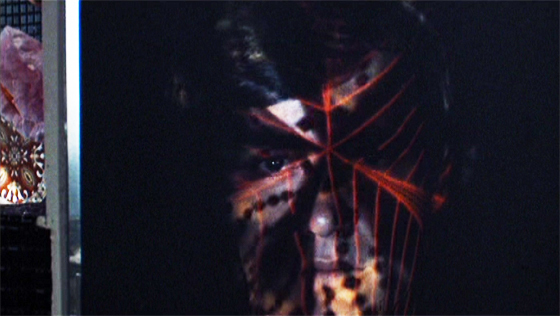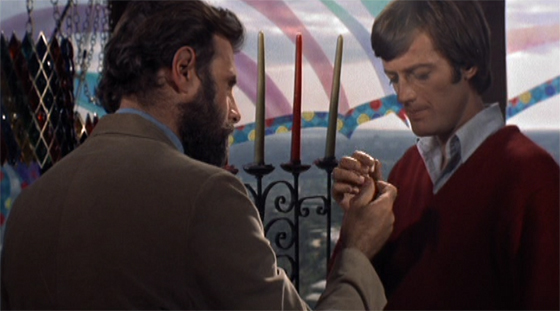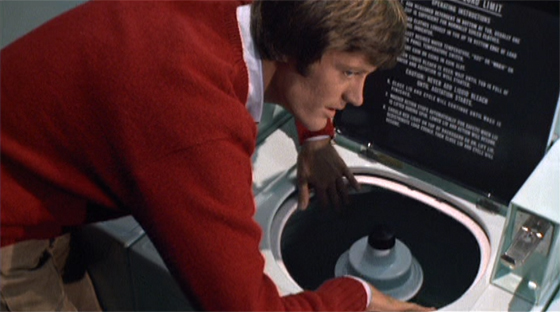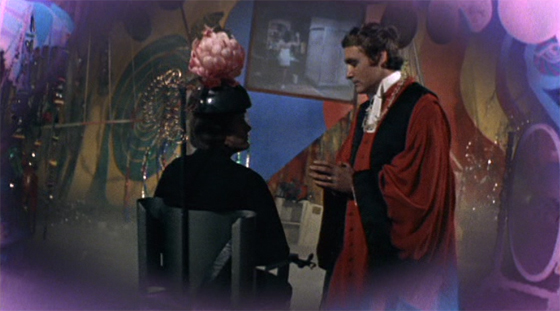
“Just close your eyes, it’s groovy now. Close them, because I’m swimmin’ in beauty. It’s all around. Let’s take a trip.” Kim Fowley, “The Trip” (1965)
“We stopped down to reality company to get some instant sleep. And the driver turned, said, ‘Welcome back,’ he smiled and he said, ‘beep beep.'” Donovan, “The Trip” (1966)
“Now, you got to do just exactly like they say. You gotta turn off your mind, and relax, and then just float downstream. OK?” -Bruce Dern to Peter Fonda, The Trip (1967)
“A Lovely Sort of Death,” reads the poster for 1967’s The Trip, which will never be confused with the 2010 Steve Coogan film. “In Psychedelic Color!” it proclaims. Early on, the film hands Bruce Dern a line of dialogue which explicitly references the Beatles’ Revolver (specifically, “Tomorrow Never Knows,” one of the band’s first LSD-inspired songs). That album’s seminal psychedelic follow-up, Sgt. Pepper, was released in June of that year, and Roger Corman’s quickie landed just two months later, at the very end of August. He wasn’t going to miss the Summer of Love. Not when there was a buck to be made.

John (Bruce Dern) delivers the pill of LSD to Paul (Peter Fonda). No relation to Lennon or McCartney.
The cast was a mix of the usual Corman repertory company with some new faces: familiar to Corman’s circle were Peter Fonda (fresh off The Wild Angels), Bruce Dern (The St. Valentine’s Day Massacre), and Dick Miller (A Bucket of Blood); Dennis Hopper and Susan Strasberg (daughter of famed acting coach Lee Strasberg) already had prolific careers in both film and television. Fans of Beyond the Valley of the Dolls (1970) won’t miss a cameo by Lance Rocke himself, Michael Blodgett. Corman company player Jack Nicholson, disappointed that his acting career wasn’t taking off the way he’d hoped it would, was beginning to dabble in screenwriting: The Trip is all his. I would assume it’s not a very thick screenplay, since there’s hardly any dialogue. I get the feeling he assembled it in his mind like an animated film: Disney’s Fantasia, but more explicitly aimed at the recreational drug crowd. Or perhaps it was to be more like a Disneyland ride. The one clever conceit of the film (I count just one) is that it is plotted around the trip itself; the title is the story. TV commercial director Paul Groves (Fonda) is prescribed a 250-microgram pill of LSD by his friend John (Dern), whose house has a swimming pool in the living room, bead curtains, candles, psychedelic art and painted walls, and even a prominently-placed copy of “Howl”…all the credentials he needs to be the tour guide to Paul’s first acid trip. About ten minutes in, Paul takes the pill, and the movie begins; you can feel the ride starting when Corman delivers a POV shot as Paul pulls a black sleeping-mask over his eyes. As the camera goes black, a psychedelic kaleidoscope show begins. This was a year before 2001: A Space Odyssey, mind you. But Kubrick’s light show was much trippier; after a minute or so of kaleidoscopes, Corman settles for a milieu he finds more comfortable: a Gothic castle on a stormy bluff (recycled footage from the Poe days), Satanic rites in a dungeon, and a dwarf and a witch stirring a smoking cauldron in what appears to be a California state park.

Paul feels some good vibrations at the laundromat.
Hallucinating that John has a gunshot wound in the head, Paul freaks out and ditches the pad, stumbling off into the night. He imagines himself to be pursued along beaches and through forests by dark, hooded figures on black horses; one assumes Paul was reading The Lord of the Rings the night before. He sees himself making love to his ex-wife (Strasberg) while swirling colored lights illuminate their bodies. And he takes an epic journey through Los Angeles: by visiting a laundromat, where he puts a quarter in a washing machine just to feel the vibrations, and by trespassing into somebody’s house so he can watch Vietnam coverage on television. When a young girl comes down the stairs to discover this stranger in the living room (shades of How the Grinch Stole Christmas?), she asks, “Who are you?” Paul replies, “I’m just a man.” Her proper reaction to this statement would be, perhaps, “AAAAAAAAAAAAHHHHHH!!!!!” Instead, she asks for a glass of milk. He pours her one, and they sit contemplatively in front of the television set. Then the girl’s father emerges from the stairs, and Paul immediately bolts out the door like Dr. Richard Kimble. Hopper, playing a character called Max (after Peter Max, perhaps, but even more Timothy Leary-esque than Dern) is briefly introduced at the start of the film but takes a significant part in Paul’s hallucinations, wearing a judge’s robe and occupying a set that looks like something from The Prisoner, replete with miniature carousel, a throne for Paul which is either an electric chair or (more likely) a salon styling chair, and a screen showing moments from Paul’s past. While Paul sits, appearing to wait for his hair to be cut, Max forces him to confront his failed marriage, and scenes of Strasberg making out with her new lover (Blodgett). When Paul says he’s getting divorced, Max asks solemnly, “Would you like that registered for or against you?” “I don’t know,” Paul says, but Max demands: “For, or against?” A dwarf riding the carousel offers, “Bay of Pigs!”, unhelpfully.

Paul hallucinates that he's interrogated in a psychedelic courtroom by Max (Dennis Hopper).
If this doesn’t seem like your typical acid trip, Corman – who dropped acid himself before making the film – confesses in the DVD supplements that there really was no way, given the technology of the time, to accurate reproduce the experience. He made use of what he had. But as hippie exploitation, it has slightly more authenticity than other films of the time, if only because Nicholson, Fonda, and Hopper were a bit more tapped into the counterculture than, say, Peter Sellers was when he made I Love You, Alice B. Toklas (1968). The three would soon collaborate on Easy Rider (1969), under Hopper’s direction. Nicholson would script the Monkees movie Head (1968) for Bob Rafelson and Bert Schneider, which, though equally sloppy and anarchic, was at least more substantial and rewarding than the more obviously exploitative The Trip. (To back up that adjective: I submit the overlong sequence set in an unconvincing hippie club – with a two-drink minimum, and Dick Miller as bartender – in which Corman lovingly photographs the large-breasted, body-paint-covered topless dancers.) Corman strategically places an opening disclaimer stating, “The illegal manufacture and distribution of these drugs is dangerous, and can have fatal consequences…this picture represents a shocking commentary on a prevalent trend of our time and one that must be of great concern to us all.” But the film, of course, is a ringing endorsement of the chemically-induced transcendental experience. The film is about nothing if not Paul’s setting aside resentment and jealousy toward his ex-wife, discovering love for the beautiful blonde (Salli Sachse) who’s been patiently waiting for him at the end of his acid trip; and not just love for her, but for everyone: “All You Need is Love” is the message of the film, and you can get there by taking LSD. Just be careful of the Ringwraiths.









